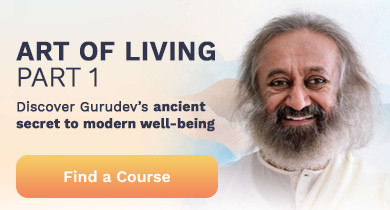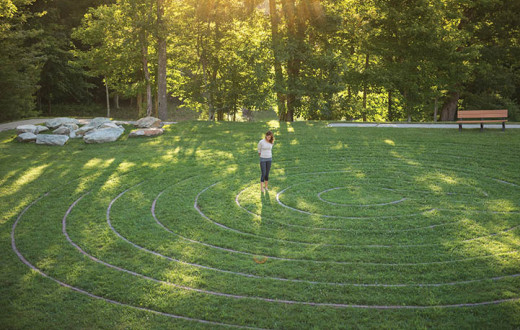
If you have tried to sit for meditation unsuccessfully, some types of music just might help you settle down, especially if you are a beginner or do not have a formal technique.
Music is typically used in three kinds of meditation: guided imagery, guided meditation, and relaxing instrumental music without guidance.
Read on to learn more about how to use music for meditation.
Why use music for meditation?

Here are some of the reasons you might want to try music for meditation:
It’s a quick and easy way to relax and get more calm
Music meditation doesn’t require any specific technique
It can help you fall asleep at night
The music can be personalized according to personal preferences
May increase mental focus
Improved mindfulness
How to use music for meditation

Gurudev Sri Sri Ravi Shankar, a master of meditation, says, "Meditation is the journey from movement to stillness, from sound to silence." He also says, "When you listen, listen not just to the sound but to the silence too." This simple guidance can enhance your meditative experience when you choose to listen to music.
Benefits of meditation with music

Music for meditation can help calm your physiology and alleviate stress in your mind, promoting relaxation and reducing anxiety
Music meditation can be a simple and relaxing practice for beginners, helping to reduce stress and promote happiness
Combining music with meditation can bring stress relief and improve your overall well-being
What is the best music for meditation?

Music without lyrics is usually best for meditating, but the instrumentation matters, too.
Gurudev has shared how specific instruments affect the various chakras (energy centers):
Drums affect the root chakra to the sacral chakra.
Wind instruments affect the sacral chakra to the solar plexus chakra.
String instruments like the sitar, veena, guitar, and piano affect the solar plexus to the heart chakra.
Metallic sounds affect the heart chakra.
Flute music and wind instruments affect the throat chakra.
Bells, sounds of water, and bird’s songs affect the throat chakra to the third eye chakra.
When all these are played together, they affect the crown chakra at the top of the head.
Any of these instruments can have a meditative effect when played properly.
Tips for how to meditate with music

Keep the volume low
If you find your mind wandering, gently redirect your attention to the sound of the music and observe the rhythm of your breath
Learn the three keys to meditation
I want nothing
I do nothing
I am nothing
Meditation music
Here are some lovely YouTube videos featuring relaxing meditation music.
Use this sunrise meditation music for your morning meditation.
Guided meditation with music by Gurudev
Enjoy this guided meditation, From Sound to Silence, where Gurudev mentions the three gunas. Guna (gunah) means energetic quality. Rajogun (rah-jo-goon) means activity and can be used to reduce Tamogun (tah-mo-goon), which means inertia. You need a certain amount of activity to become quiet; then meditation can happen. The third guna, sattva guna (sat-va-goon), means purity and harmony, which happens during deep meditation.
Here’s another guided meditation that uses music for a deeper meditation experience: Cosmic Sounds.
For more free guided meditations, check out Guided Meditation: Help for Anxiety, Stress, Sleep, and More.
Music with Sanskrit singing and deep meditation

From ancient times, people have gathered in satsangs to sing in Sanskrit for deep meditation. Musical instruments and voices in unison create an atmosphere conducive to transcending thoughts and experiencing palpable calm. The songs, or bhajans, are led in a call-and-response style, often called kirtan. Sometimes, satsangs lead to meditative, ecstatic dance and euphoria. These songs can also be used at home right before your meditation practice. Click here to learn more about this musical meditation practice.
You may also want to check this meditative music by John Osborne, a senior faculty member of the Art of Living Foundation, from Sound into Silence.
Experience the journey from sound to silence

Mantra meditation
A mantra is an ancient sound given by a meditation instructor, which is taken internally and kept silent as a vehicle for effortless, deep meditation.
Silent meditation
This type of meditation can be done in a group on a silent retreat or as a solo practice. If this is something you aspire to, you may want to attend a guided silent retreat. The Art of Living Part 2 course truly embodies the journey from sound to silence. These courses are available in person and online.
Breathing meditation
The sound and very nature of our breath is a perfect vehicle for meditation. The connection between breath, body, and mind is an intrinsic part of the journey from sound to silence. The Art of Living Part 1 course delves deep into using the breath to take you to the door of meditation. In the part 1 course, you will learn SKY Breath Meditation and other breathwork techniques. Here are some of the benefits practitioners enjoyed and researchers have confirmed:
60% stress reduction
Healthier blood pressure
Reduced anxiety
Reduced depression
Enhanced deep sleep
Better focus
Increased joy
Register today and start enjoying reduced stress and more!
Related articles

A Beginner’s Guide to Daily Meditation
What is Meditation? 12 Ways It Can Help You and How to Begin
Meditation for Beginners Simplified: Sit Back, Close Your Eyes, Relax!
Try Our 10-Minute Meditation for When Time Is of The Essence
What Is the Best Time to Meditate? Morning, Noon, Or?
Meditation Journaling: Get the Most Out of Your Meditations
Meditation Retreats Near Me: Find the Best with Our Guide Today
Why Meditate: 25 Signs For You to Start Meditating Everyday
How to Keep Your Mind Healthy: 5 Tips of Meditation To Try
Feeling Stressed? Relaxation Meditation Can Help You Today
5 Tips on How to Deal with Anger
Escape the Chaos: Start Your Day with This Peace of Mind Meditation
Meditation is the Key to Investing In Your Mental Health
Meditation for Grief: Breathe in Love, Breathe Out Grief
What is Mindfulness? A Simple Guide to Meditation Training
Beyond Mindfulness™: Unlock the Secrets To a Happier Life Now
Learn the Art of Mindful Eating for a Happier Mind and Body
Yoga and Meditation: 3 Simple Ways You Can Get Started Today
Reduce the Risk of Burnout with Meditations at Work
Meditation for Seniors: The Zen Time of Your Life Starts Now
Incense for Meditation: Benefits, Best Scents, and More






























